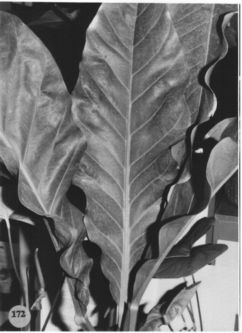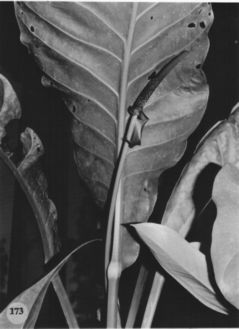





Anthurium schlechtendalii Kunth,
Enum. PI. 3: 75.1841.
Anthurium mexicanum Liebm., Vidcnsk. Meddel. Dansk
Nalurhisl. Forcn. Kjebenhavn 1:21. 1849. TYPE: Mexico. Veracruz: between
Colipa & Misanlla (not seen).
Anthurium kunthianum Liebm., Ann. Sci. Nat. Bot.,Ser.
IV, 2: 372. 1854. TYPE: Mexico (no type cited).
Anthurium brachygonatum Scholt, Prod. Aroid. 468.
1860. TYPE: Mexico. Veracruz: Cordoba, Kerber s.n. (B) (see discussion).
Anthurium tetragonum Hook. ex Scholl, Prod. Aroid.
475. 1860. TYPE: Locality unknown (not seen).
Anthurium foninense Engl., Bot. Jahrb. Syst. 25:
366. 1898. TYPE: Mexico. Veracruz: Forlin, Kerber 9b (B).
Anthurium tikalense C. Lundell, Wrightia 3: 161,
Fig. 55. 1966. TYPE: Guatemala. Peten: Tikal National Park, on temple in
Group "H," March 1, 1961, C. L. Lundell 18198 (LL).
LEAVES erect; petioles 12-23 cm long, 0.5-2 cm wide, trapezoidal, the abaxial margins sometimes sharply to obtusely ribbed, widest adaxi-ally, shallowly sulcate; geniculum 1-2 cm long; blades obovate-elliptic, thick, acute to short-acuminate at apex, acute to obtuse at base, 30-112 cm long, 10-58 cm wide; broadest near or above middle; both surfaces matte to semiglossy; midrib flat to weakly rounded at base above, becoming more acute sometimes weakly ribbed, diminished and sunken at apex, raised and square at base below, rounded at apex; primary lateral veins 15-16 per side, raised on both surfaces, departing midrib at 50° angle, straight nearly to margin, then arching toward apex, lesser veins scarcely visible; collective vein arising from primary lateral vein in apical one quarter of blade, 2-5 mm from margin, sunken above, raised below.
INFLORESCENCE spreading, shorter than leaves; peduncle 33-43 cm long, 6-11 mm diam., terete to weakly flattened and ribbed; spathe coriaceous, green heavily tinged with violet-purple, linear-lanceolate to lanceolate, 1 5-28 cm long, 1.5-5 cm wide, acuminate at apex, obtuse at base, strongly reflexcd, inserted at 70° angle on peduncle; spadix green, 8-29 cm long, 1.7-2 cm diam. at base, 4-6 mm diam. at apex; flowers square, 2.2-2.6 mm in both directions, the sides straight to weakly sigmoid; 7-17 flowers visible in the principal spiral, 10-14 flowers visible in the alternate spiral; tepals green, matte, with purple punctations, the outer margins purplish, lateral tepals 1.1-1.3 mm wide, the inner margins convex, turned up against pistils; pistils emergent
to 1 mm, dark purple; stigma linear, 0.8 mm long, with minute droplet ca. 4 days before stamens emerge, dry, black as stamens emerge; stamens emerging rapidly from the base, lateral stamens emerging to midway before alternate stamens emerge, exserted on translucent filaments, ca. 0.5 mm long, 1 mm wide, which retract to hold anthers at side and inclined over pistil; anthers pale orange, 0.9 mm in both directions; thecae ± oblong, scarcely divaricate; pollen pale orange fading to cream.
INFRUCTESCENCE arching-pendent; spathe brown, persistent; spadix up to 65 cm long, 5 cm diam.; berries bright red, lanceolate-elliptic 1-1.5 cm long; pericarp thick; mesocarp pulpy, white, with numerous raphide cells; seeds 2, greenish-white, 5.5-6 mm long, ca. 1.5 mm wide. Figs. 172 and 173.
Anthurium schlechtendalii is in section Pachyneurium and consists of two subspecies. The subspecies schlechtendalii ranges from Mexico (central Veracruz) to Nicaragua on the Atlantic slope at an elevational range from near sea level to 1,600 m (most commonly below 1,000 m).
This species is most closely related to A. schlechtendalii ssp. jimenezii from the Pacific slope of Mexico, which differs by occurring in seasonally drier habitats, by its generally smaller leaves, and by its frequently narrowly ovate, usually erect spathe.
Anthurium schlechtendalii merges into the range of A. salviniae only in a few areas in the mountains of southeastern Chiapas, such as on Monte Ovando, where both species were seen growing. Specimens collected in the municipios of Siltepec, Escuintia, and Acacoyagua tend to have leaf blades approaching the texture of those of A. salviniae but have the inflorescences and cataphylls of typical A. schlechtendalii. See discussion following A. salviniae for separation characters for these two taxa.
In discussing Mexican aroids, Bunting (1965) included an illustration of a plant cultivated at Comell University and reputedly collected by H. Moore in Mexico. This is almost certainly A. crenatum (L.) Kunth from the West Indies and perhaps represents a mixing of labels in the greenhouse. Two vouchers presumably prepared from this plant (Bunting 1579 and Nicolson 603) tend to confirm this. Anthurium crenatum so far as is known is restricted to Puerto Rico and the Virgin Islands.
Studies of populations of A. schlechtendalii in Mexico and elsewhere show most morphological characters to be variable. Petiole shape, although usually trapezoidal in cross-section with the angles moderately acute, may be broadly rounded abaxially, such as those illustrated by Schott for A. brachygonatum [see Schott drawing No. 473 (W)]. Although Bunting (1965) considered this distinct from A. schlechtendalii, it is believed to be a form of an unusually variable species.
 |
 |
Map of Mesoamerican specimens with coordinates
Belize Toledo: 700-750 m, 16.23N 89.09W, 6 April 1992, Bruce K. Holst
4069 (MO).
Belize Toledo: 20 m, 16.16N 88.52W, 6 May 1996, Bruce K. Holst, G.
Davidse & A. Whittemore 5132 (BRH, MO).
Honduras Santa Bárbara: Lake Yojoa,, 24 May 1972, Clewell 3114
(FSU).
Mexico Chiapas: 880 m,, 25 Oct. 1988, Breedlove 70688 (CAS).
Mexico Chiapas: Mpo. Tenejapa, 1600 m,, 11 Nov. 1988, Breedlove 71373
(CAS).
Mexico Chiapas: 900-1050 m, 15.27.N 92.38W, 21 August 1996, Thomas
B. Croat 78444 (CM, MO).
Mexico Mexico:, 1841-42, Karwinsky, W. 836 (MW).
Mexico Oaxaca: Dtto. Tuxtepec, Mpo. Soyaltepec, 140 m, 18.14N 96.23W,
21 May 1986, Gereau et al. 2237 (MO).
Mexico Oaxaca: Dtto. Tuxtepec, Mpo. Acatlan, Cerro Buenos Aires, 70
m, 18.28N 96.38W, 19 May 1986, Gereau et al. 2209 (MO).
Mexico Oaxaca: Dtto. Tuxtepec, 200 m,, 31 Jan. 1983, Neill 5400 (MO).
Mexico Yucatan: Mun. de Valladolid. Xuilub., 25 m, 20.29N 88.05W, 24
Oct. 1989, Mogensen 1164 (AAU).